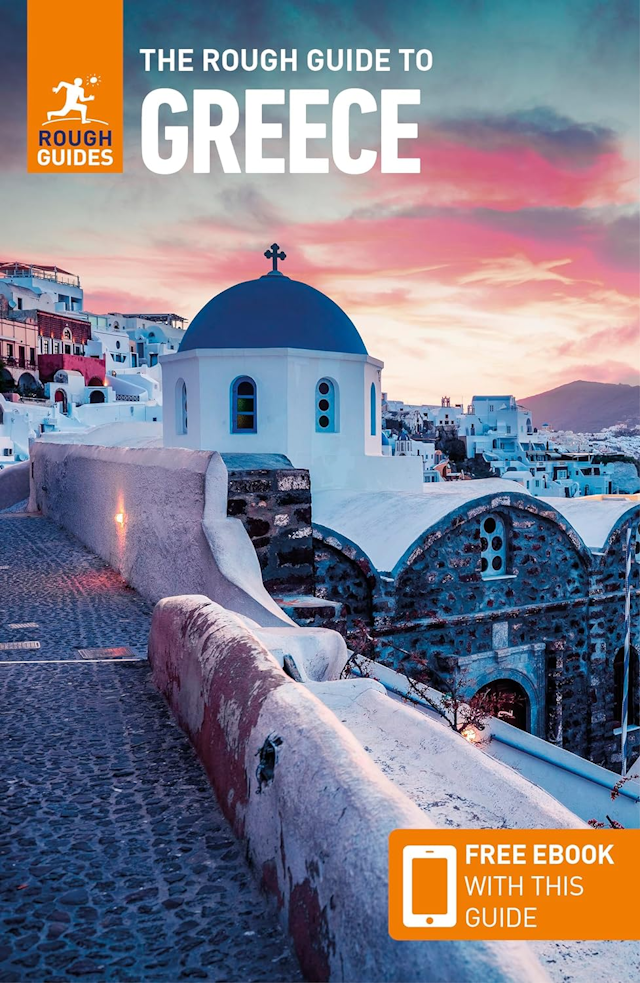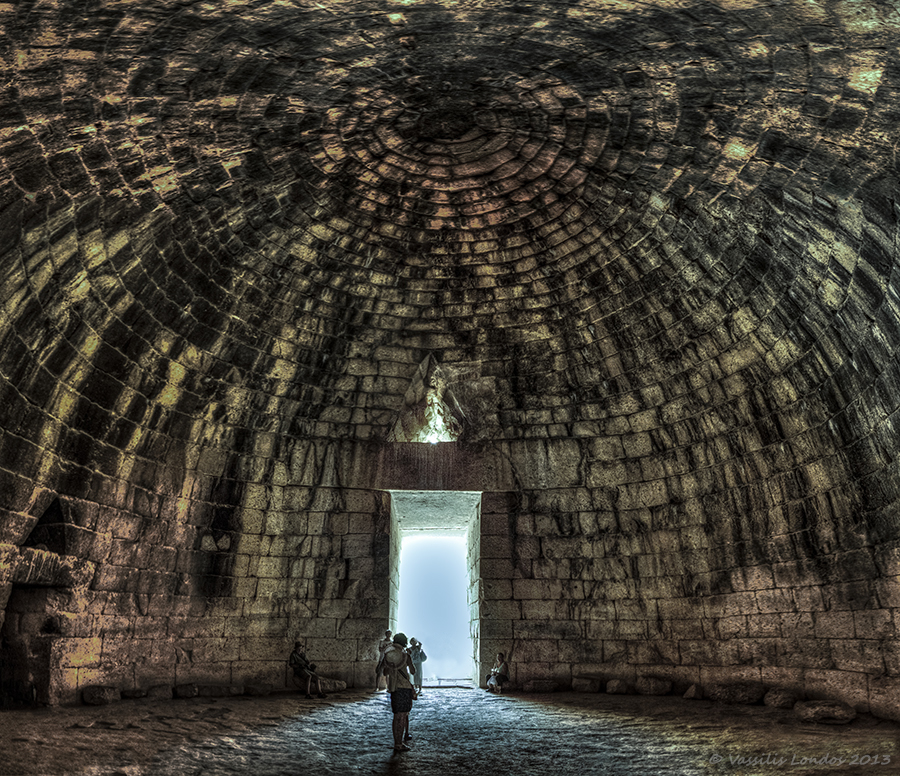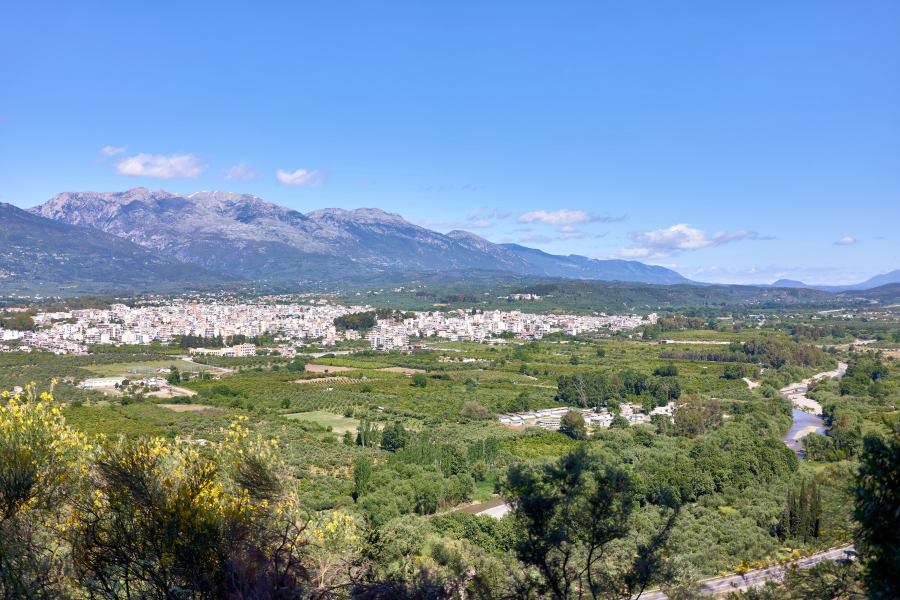- HOME
- Peloponnese
- Tiryns
Tiryns
The Greece Travel Secrets guide to the ancient archaeological site of Tiryns, near Mycenae, in the Peloponnese of Greece, a UNESCO World Heritage Site.
Where is Tiryns?
Tiryns is about 20 kms (12 miles) south of Mycenae, and 5 kms (3.1 miles) north of Nafplion in the Peloponnese of Greece. If you're based in Nafplion it's easy to combine visits to the two sites in one day, or if you're driving from Athens to Nafplion and make an early start you can also visit both sites on your journey.
Tiryns is about a 90-minute drive from Athens, or about two hours from Athens International Airport. There is some accommodation near Tiryns but our advice would be to stay in Nafplion and make the 5-minute drive to Tiryns.
 Map (c) Google Maps
Map (c) Google MapsWhy Is Tiryns Famous?
The site is mainly famous for its impressive fortifications, which date back to the Bronze Age, and for being one of the main centers of the Mycenaean civilisation.
How Old is Tiryns?
The earliest evidence of settlement in Tiryns dates back to the Neolithic period, around 4000 BC. However, it was during the Bronze Age that the site became an important center of Mycenaean culture, which flourished in Greece between 1600 and 1100 BC.
Mycenean Civilisation
The Mycenaean civilisation is known for its monumental architecture, including large palaces, tombs, and fortifications. Tiryns is particularly famous for its fortifications, which were built in several phases between the 15th and the 13th centuries BC. The walls of Tiryns are among the most impressive and well-preserved examples of Mycenaean military architecture.
Tiryns Fortifications
The first fortifications at Tiryns were built around 1500 BC, during the Middle Helladic period. These walls were made of stone and mud-brick, and they encircled the hill on which the palace and other buildings were located. However, these walls were not very strong and were replaced by new, more massive walls around 1400 BC.
The Walls of Tiryns
The new walls were built of huge limestone blocks, some of which weigh over 10 tons. These blocks were carefully fitted together without mortar, using a technique called "Cyclopean masonry," which is named after the mythical race of giants who were said to have built the walls. The walls were up to 7 meters (23 feet) thick and over 10 meters (33 feet) high, with towers and bastions at strategic points.
The construction of such massive walls required a large workforce and a high degree of organization. It's believed that the Mycenaean rulers of Tiryns controlled a large territory and had access to a substantial labor force, including slaves and prisoners of war.
The Palace of Tiryns
The Palace of Tiryns was located within the walls and was the residence of the Mycenaean rulers. The palace was a complex of buildings, including a central hall, private rooms, and storage areas. The central hall was the most impressive part of the palace and was used for public ceremonies, feasts, and other important events. The hall had a large hearth in the center and was decorated with frescoes and other artworks.
Tiryns was an important center of Mycenaean culture and played a role in the wider Mediterranean world. The Mycenaeans were skilled traders and sailors and maintained contacts with other civilisations, such as the Minoans on the island of Crete and the Egyptians.
Tiryns was also involved in the Trojan War, which is described in Homer's Iliad. According to the legend, the Mycenaean king Agamemnon gathered a large army at Tiryns and sailed to Troy to recover his wife, who had been kidnapped by the Trojan prince Paris.
Rediscovery of Tiryns
In the centuries that followed, Tiryns declined in importance and was eventually abandoned. The site was rediscovered in the 19th century by German archaeologist Heinrich Schliemann, who also excavated the nearby site of Mycenae. It's now a UNESCO World Heritage Site.
Latest Posts
-
Explore Vikos Gorge: Hiking, Rafting, and Food in Zagori
One of the most impressive canyons in Europe and one of Greece’s favorite mountain destinations, Vikos Gorge invites hikers and food lovers alike. -
Lefkada: The First Ancient Theater of the Ionian Islands Comes to Light
The first ancient theater ever discovered in the Ionian Islands is located in the heart of the ancient city of Lefkada, established before the end of the 7th century BC. -
5 Epic Island Hikes in Greece for Spring Explorers
This spring, five majestic peaks across Greece’s islands invite us to lace up our boots and discover a wilder side of island life. -
Greek Ferry Services to Halt on May 1 Due to Labor Strike
Ferries in Greece will remain docked for 24 hours on Thursday, May 1, as the Pan-Hellenic Seamen’s Federation (PNO) joins Labor Day mobilizations announced by the General Confederation of Greek Labor… -
Sifnos: Greece’s Hidden Culinary Star on the Rise
Sifnos, a Cycladic island, is gaining fame for its rich culinary heritage, especially the beloved melopita honey-cheese tart. -
Easter in the Mystical Castle of Monemvasia
In the castle town of Monemvasia, with its dramatic medieval backdrop and sea views, Easter is a deeply spiritual and atmospheric experience. -
Easter in Leonidio: A Tapestry of Light, Culture and Cliffs
In Leonidio, Easter comes alive with handmade hot air balloons in the sky and lanterns made from bitter oranges in the streets. -
The Lesser-Known Traditions of Greek Easter
Step off the beaten path this spring and discover the enchanting — and often surprising — Easter traditions found across Greece. -
April 9 Strike in Greece to Impact Public Transport, Ferries and Air Travel
Transportation and travel across Greece will face disruptions on Wednesday, April 9, as public transport, ferry and aviation workers join a nationwide strike called by Greek labor unions. -
Ancient Theater of Lefkada Brought Fully to Light Following Systematic Excavation
The Greek Culture Ministry has announced that the first ancient theater ever identified in the Ionian Islands has recently been brought fully to light on Lefkada, revealing an impressive monument that…

























